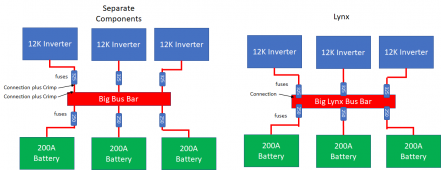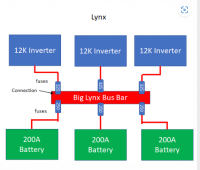FilterGuy
Solar Engineering Consultant - EG4 and Consumers
What I really like about the distributor is that it allows you to combine Fuse Holders with the busbar.I don't see the distributor adding anything to the above scenario?

Note that on the Lynx, two crimps and a connection are eliminated for each fuse.
This is more than just making it easier to build and/or nicer looking. This is a functional improvement. Each connection and each crimp adds resistance and it adds up. This cumulative resistance can create significant voltage drops as the current goes up. Just two days ago I was working on a system that had a very clean build with excellent crimps and heavy-duty bus bars but the system was suffering a significant voltage drop between the battery and the inverter. We are now considering re-wiring things to reduce the number of crimps/connections in order to reduce the voltage drop.
I used to be a never-fuser but over time I have changed my mind.I don't really want fuses in my system if I can avoid it, would rather have breakers trip in case of a fault.
Quality DC breakers are going to be large and expensive. Furthermore for anything over about 150A you are going to find it hard to find one that does not require a breaker box to mount them. (Warning: There are a lot of cheap 200+A breakers out there that are more likely to start a fire than prevent one)
Meanwhile, quality, name-brand fuses are much more compact, easier to mount, and less expensive.
About now the never-fusers are saying "But what if the fuse blows..... then I have to get a replacement and I might not have one handy....the convenience is worth the extra cost!!" That used to be my point of view as well. However, blowing a 250A fuse is a catastrophic event that should never happen in normal operations. Something went really big wrong for that to happen. (Or the design is *really* bad). If a 250A Fuse blows, there is a good chance that replacing the fuse will be the least of your worries.
Last edited:





